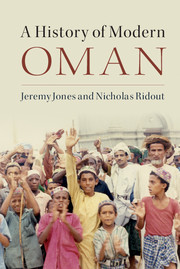3 - Oman in the Age of British Ascendancy and the Arab Nahda
from Part One - Foundations
Published online by Cambridge University Press: 05 September 2015
Summary
In the period between the death of Sayyid Said in 1856 and the accession of his namesake, Sultan Said bin Taimur, in 1932, Oman experienced a complex process of change, often described in terms of decline and marginalisation. As British imperial consolidation in the second half of the nineteenth century played a major role in the development of a global economy dominated by the industrialised nations of the North, and driven by their colonial appropriations, both Oman and Zanzibar, which had been very much part of this process in the first half of the century, found themselves increasingly excluded from it. The separation of the two main parts of Sayyid Said's ‘thalassocracy’ – Oman and Zanzibar – from one another was a major factor in this process of decline. The marginalisation of Oman itself involved the decline of local and regional trade in the Gulf, as a result of the development of steamer traffic in the Indian Ocean and the gradual replacement of a regional economy dominated by Indian manufactures and trade networks by a system dominated by the British. This had substantial political consequences for an Omani elite whose power had been built on its participation in the earlier interregional trading networks. In effect, Oman was simply left out of the action, as trade no longer passed through its formerly thriving port cities. In Zanzibar, a slightly different process ensued, in which trade continued apace, but the commercial and political alliance between the Omani ruling elite and the Indian merchant class gave way to increasing British domination. In Zanzibar, the action was seized by the British from the Omanis. However, although these changes did significantly limit Omani participation in the emerging networks of the globalising economy, there were related developments that served to incorporate Oman and Omanis into new 65transnational networks, including, most significantly, those that involved intellectual and political opposition to the emergent colonial world order. In this chapter we show how these new movements, shaped by a renewal of Muslim religious and political thought – the Arab nahda – interacted with long-standing aspects of Omani religious and political culture to offer an alternative to Al Bu Said rule, identified by many during this period as excessively dependent upon British power.
- Type
- Chapter
- Information
- A History of Modern Oman , pp. 64 - 96Publisher: Cambridge University PressPrint publication year: 2015

